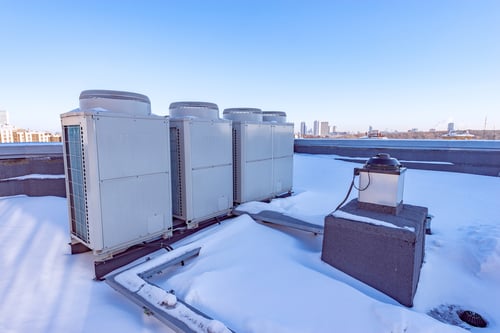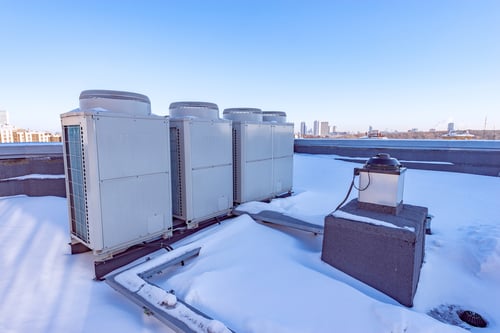Variable refrigerant flow (VRF) systems are among the most efficient and flexible HVAC solutions, utilizing heat pumps to provide heating and cooling. VRF systems also require less space than many other installations, using compact refrigerant lines rather than extensive ducting or hydronic piping. They also consolidate heating and cooling into a single system.
When a building uses a VRF system during the winter, ice buildup on the outdoor unit can degrade performance. The unit's heating capacity is gradually reduced as ice builds up on the outdoor coils and excessive freezing can damage the system. To solve this problem, manufacturers use a defrost cycle that reverses the operation of the heat pump:
- A heat pump in defrost mode works similar to an air conditioner, removing heat from indoor air and releasing it outside.
- The release of heat melts the ice accumulated on the external coil.
- When the outdoor unit is defrosted, the heat pump returns to heating mode.
The defrost cycle works with automatic controls and there are many possible settings. For example, some VRF systems enter the defrost cycle at regular intervals based on the outside temperature. Other defrost controls measure the heat transfer coefficient or pressure of the external coil to detect performance losses caused by frost, activating the defrost cycle when necessary.
Get a professional VRF system design for your next construction project.
An air source heat pump (ASHP) that meets the requirements below is considered a ccASHP (Cold Climate ASHP), which makes it suitable for very low temperatures:
- A heating seasonal performance factor (HSPF) of at least 10.
- A Coefficient of Performance (COP) of 1.75 at 5°F.
How the defrost cycle limits heating capacity
While the defrost cycle is convenient, it has an important limitation: Interior spaces are unheated while the process lasts, and defrost cycles are needed more frequently as the outside temperature drops. This leaves indoor areas unheated for longer periods, precisely when it is most needed.
- When outdoor temperatures limit the performance of a VRF heat pump, a common solution is to add a backup heating system. Typically, the backup system uses a resistance heater or gas burner.
- However, some heat pump manufacturers have developed ways to optimize the defrost cycle. This makes VRF systems less dependent on backup heat.
Heating loss caused by the defrost cycle can be mitigated by having multiple outdoor units and programming them to avoid simultaneous defrosting. For example, if a VRF system has four outdoor units and the defrost cycle is programmed for two at a time, the building only experiences a partial loss of heating power.

This article compares VRF heat pump systems from several leading manufacturers, focusing on minimum temperature rating and defrost cycle operation. The brands compared are Daikin, Mitsubishi and Panasonic.
- All three manufacturers have product lines rated for temperatures of -4°F or below.
- Although the defrosting cycle is inevitable even with top brands, some technologies have been developed to mitigate its impact.
Daikin VRF systems
Daikin invented variable refrigerant flow technology and other manufacturers have developed competing products. Daikin uses the term Variable Refrigerant Volume (VRV), which is a registered trademark. Therefore, you will find that their products are marketed as VRV systems, while those from other manufacturers use the term VRF.
Daikin VRV systems utilize several methods to mitigate performance loss caused by the defrost cycle. Please note that the specific defrost setting changes depending on the product.
- Daikin has developed a heat accumulator for its VRV systems, which continues to provide heat while the defrost cycle is active.
- Some heat pumps have an external dual heat exchanger and only one coil is defrosted at a time. VRV heating power remains above 30% with this configuration.
The minimum operating temperature of VRV systems depends on the specific model. The following table lists the minimum temperatures for the main Daikin product lines, along with the maximum defrost cycle duration:
|
DAIKIN VRV System |
Min. Temperature. |
Maximum Defrost Duration |
|
VRV AURORA heat recovery |
-22°F |
Information is not provided by the manufacturer |
|
VRV IV Heat Recovery |
-13°F |
15 minutes |
|
VRV IV heat pump |
-4°F |
15 minutes |
|
VRV III heat recovery |
-4°F |
5.5 min per unit (6 and 8 ton units) |
|
VRV IV S series heat pump |
-4°F |
12 minutes |
Heat pump VRF systems are those that provide cooling or heating to all zones, while heat recovery VRF systems allow simultaneous heating and cooling for different areas.
Mitsubishi VRF Systems
Mitsubishi's VRF product line is called CITY MULTI and is rated for temperatures down to -13°F. Mitsubishi developed Hyper Heat technology to minimize the need for defrosting:
- With the Hyper Heat system, one of the hot refrigerant lines circulates through the outdoor VRF unit. The heat released slows ice build-up or can stop it altogether.
- The normal defrost cycle is only activated in extreme cases where the Hyper Heat system is unable to defrost the unit on its own.
The CITY MULTI product line is classified as follows:
|
Product Series |
Description |
Max. Defrosting duration |
|
R2 Series |
Heat recovery |
12 minute defrost cycle |
|
R2 H2i Series |
Heat Recovery with Hyper Heat |
Same as above |
|
Y Series |
heat pump |
Same as above |
|
Y Series H2i |
Heat Pump with Hyper Heat |
Same as above |
|
Series |
Compact heat pump |
10 minutes |
All five product series can be equipped with low-temperature accessories, which reduce their operating range down to -18.7°F. In particular, the R2 Series with Hyper Heat can operate in temperatures as low as -25°F with corresponding accessories.
Panasonic VRF Systems
Panasonic's VRF product line is called ECOi and includes three main series:
- MF2 Series: 3-way VRF heat recovery
- ME2 series: 2-way VRF heat pump
- Mini ECOi LE Series: 2-way VRF for residential and light commercial use
The minimum operating temperatures and defrost conditions for Panasonic VRF systems are summarized in the following table:
|
Panasonic VRF |
Min. Temperature. |
Max. Defrosting duration |
|
MF2 Series |
-13°F |
15 minutes single unit, 23 minutes multi unit |
|
ME2 Series |
-4°F |
15 minutes single unit, 18 minutes multi unit |
|
Mini ECOi |
-4°F |
Information is not provided by the manufacturer |
Conclusion
There is a wide range of VRF systems on the market and there are important differences in the operating temperature range. The design and specification process is very important when dealing with VRF systems, as even a high-quality product can underperform when it does not match the application. Additionally, installation should be performed by a qualified contractor, as many VRF performance problems can be attributed to poor installation procedures.
With a proper design and installation process, VRF systems are among the highest performing HVAC installations. They can achieve significant air conditioning savings during the summer and provide local emission-free heating during the winter.

